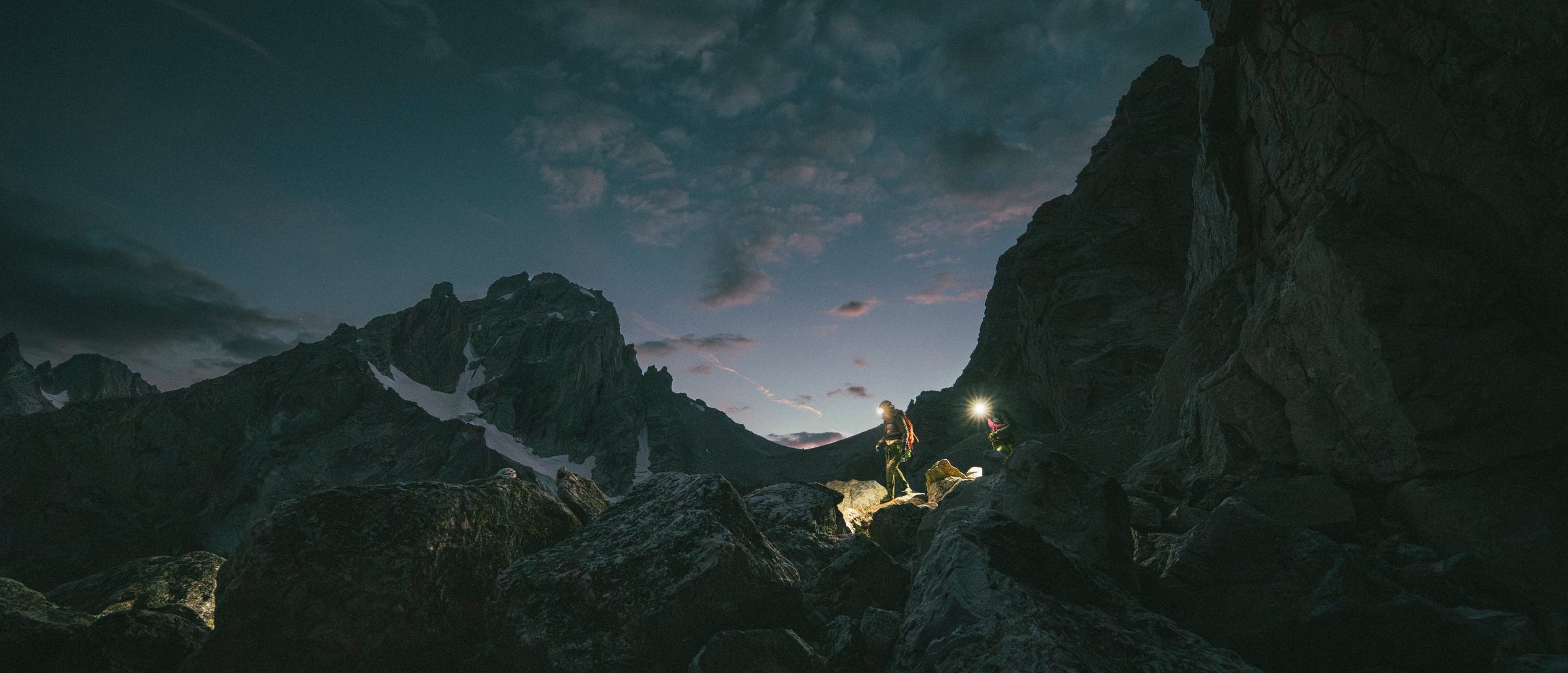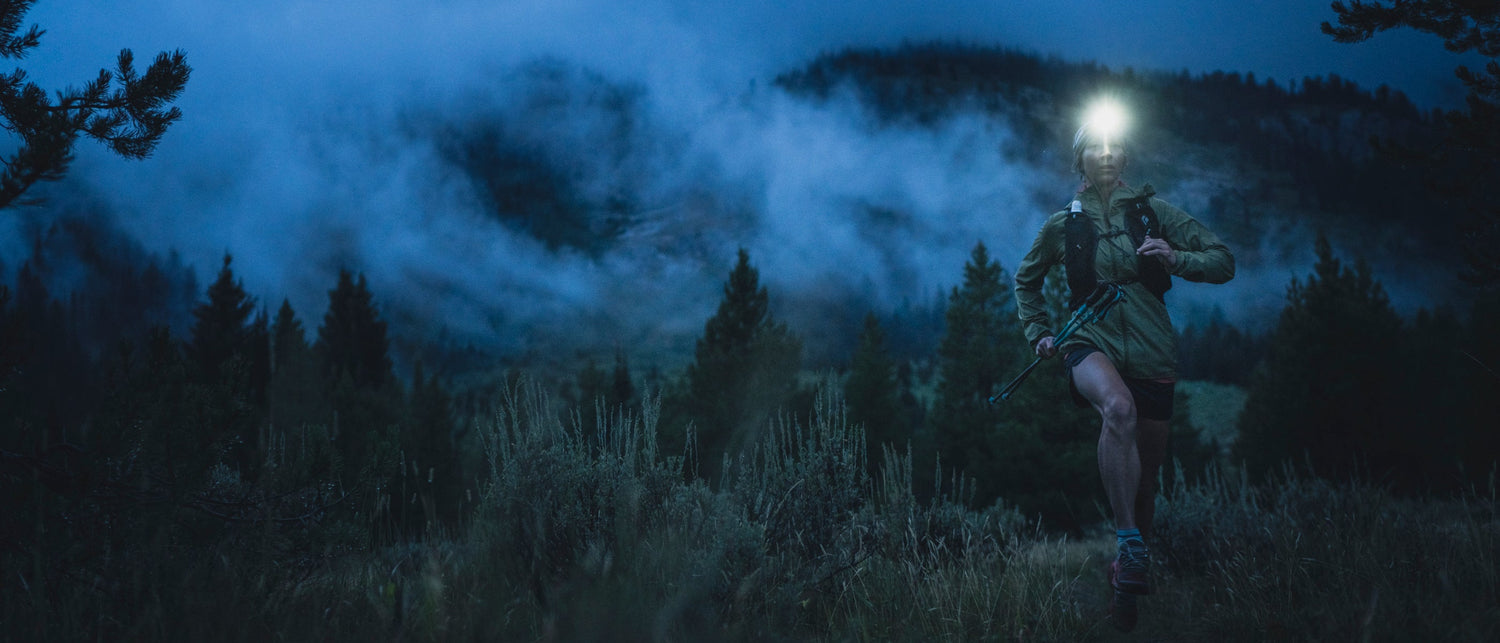
How to Choose the Best Headlamp
Maybe you’re running an ultramarathon and pushing through the night, or perhaps you’re fixing your kitchen sink late at night; in either scenario, you’re probably reaching for a headlamp at a critical moment in the process. Nowadays, headlamps are used for a wide range of activities, from running, climbing, and skiing to commuting and house chores. And of course, nearly every climbing trip begins with the question, “Did I remember my headlamp?”
With recent advances in lighting and new products over the years, it can be hard to decide which product to buy when setting out to purchase a new headlamp. That’s where we come in. Black Diamond has been at the forefront of headlamp innovation, from our patented PowerTap™ technology to long-lasting rechargeable batteries. We’re here to break down the main considerations when buying a new headlamp and help shed some light on which of our products work best for specific uses.
WHAT SHOULD YOU CONSIDER WHEN BUYING A HEADLAMP?
WHAT SHOULD YOU CONSIDER WHEN BUYING A HEADLAMP?
LUMENS
What are lumens, anyway? Lumens are a way of measuring how much light is emitted from a light source. A higher lumen count, say over 400 lumens, means more light output, which is essential for route-finding and navigating challenging terrain. Headlamps with a lower lumen count, between 150 and 250 lumens, are sufficient for basic uses like reading and cooking at camp. It’s also important to note that running a higher lumen light at a medium brightness will allow the battery to last longer—something to consider for situations where you’ll be running a light for a long time. This is part of the reason our top-of-the-line running headlamps, the Distance 1500 and Distance LT 1100 have such high lumen ratings. If you are running through the night, you probably only need your light at 400-600 lumens for most of the night. But if you want your light to last hours, the max lumens need to be higher. Also, getting a blast of 1500 lumens when you need to find your way can make or break a late-night endurance push.
RECHARGEABLE VS. DUAL FUEL
How your headlamp maintains a charge is an important factor when deciding which model to buy. Your main use case, trip length, and convenience preferences are all things to consider when deciding between a fully rechargeable headlamp and a battery-powered option. Rechargeable headlamps are more powerful than their battery-powered alternatives. They last longer and generally offer a higher lumen count, making them a good option for dedicated outdoor users. Dual-fuel models are powered by either AAA batteries or a rechargeable 1500 battery pack. These lights are useful for long expeditions or for those seeking a more affordable option.
BEAM TYPE
Our fleet of headlamps has a range of beam types and distances. Generally, the farther the beam reaches, the more useful the light will be for activities requiring long-range sight, like route-finding on a hike or mountaineering. A closer beam distance is helpful for tasks like reading, cooking, or late-night repairs. Many of our lights transition between a flood or spotlight setting with a single button click, making them versatile for a range of nighttime uses.
Our Distance 1500 and Icon 700 headlamps have the farthest beam distance—almost 150m, while the Deploy and Sprinter 500 have the shortest—around 50m. Lumens are not always an indicator of beam distance; lens construction can affect beam distribution.
LENS CONSTRUCTION
A good lens construction on your headlamp means the light emitted from your headlamp is bright and high-quality. A bad lens can lead to light discoloration, dark spots, and poor diffusion. At BD, we design and test all of our headlamp lenses to make sure our headlamps have the highest quality light distribution. We send our lenses to a PhD in Photometry in Colorado for testing and modelling during design.
It can be hard to determine a quality lens on your own, but if you see yellowing on the edges of the light or dark spots in the middle of the illuminated area, it can be an indicator of a poor lens.
BODY CONSTRUCTION
In addition to considering the technology of the light, you also want a headlamp that fits comfortably and has a headband that suits your needs. Some of our running headlamps have a removable, third strap for added security. On our Distance LT 1100 headlamp, only the LED lens tilts to prevent the headlamp from bobbing while you run. Our Deploy Headlamp has a streamlined body and band construction, making it ultra-comfortable and secure for running.

A LIGHT FOR EVERY ACTIVITY
A LIGHT FOR EVERY ACTIVITY
BEST HEADLAMPS FOR RUNNING
The Distance 1500 is our pinnacle running headlamp, built for the biggest endurance pushes that take you through the night. It runs using an interchangeable external battery pack. A step down in lumen output is the Distance LT 1100, which is super packable and great for mountain missions where weight counts. For pre-dawn runs or after-work jaunts, the Deploy Run Light is the ticket.
BEST HEADLAMPS FOR CAMPING AND GENERAL USE
Dual-fuel compatible, low-profile, and compact, the Spot 400 is a great option for versatile outdoor use. Throw it in your climbing pack or use it for setting up camp late at night—this simple light gets it done. For an affordable, lightweight alternative, the Cosmo 350 is a great option. It can be powered by batteries on multi-day overnights but is also rechargeable for quick weekend trips.
BEST HEADLAMPS FOR CLIMBING
For long, alpine pitches and technical terrain in the dark, the top-of-the-line option is the Icon 700; it is extremely powerful, waterproof, and swaps between modes easily. The top strap is removable, making it easy to strap onto your helmet. The Storm 500-R is a bit simpler in design but still provides reliable, powerful lighting for climbing missions in variable conditions. For everyday climbing missions, the Astro 300 is a compact, extremely simple headlamp that is great as a just-in-case light, perfect for keeping in the bottom of your pack.
FINAL CONSIDERATIONS
FINAL CONSIDERATIONS
Rechargeable headlamp technology has improved so much recently that we’d highly recommend getting a rechargeable model for most use cases. Crushing through AAA batteries to charge your headlamp is less sustainable in the long run. To power our rechargeable headlamps in the field, it’s helpful to have an external power bank. Our dual fuel lights can be powered by the BD 1500 rechargeable battery, which comes with a USB-C charger and features a 1500 mAh Lithium-Ion rechargeable cell.
Most of our headlamps have a variety of settings, including proximity and distance modes, dimming, strobe, red LED night-vision, and lock mode. The majority of our lights also have a Brightness Memory function and integrated patented PowerTap™ technology, letting you quickly jump to full brightness when you really need to illuminate the way. Beyond looking at the lumens, it’s worth diving into the details of each lamp’s feature set before making your final decision. The light needed for your pursuit is as unique as your mission. At Black Diamond, we’ve created a line-up of headlamps capable of defying the dark for any mission in the mountains.
KEY TAKEAWAYS
KEY TAKEAWAYS
- Key buying factors: When choosing a headlamp, consider lumens (brightness), power source (rechargeable vs. dual-fuel), and beam type, depending on your activity, and body construction for comfort and durability.
- Performance and battery: Higher lumens offer better illumination for navigation and endurance pushes, while medium brightness settings extend battery life. Rechargeable models are more powerful and sustainable, while dual-fuel options provide flexibility for longer trips.
- Activity-specific models:
- Running: Distance 1500, Distance LT 1100, and Deploy Run Light.
- Camping/General Use: Spot 400 and Cosmo 350.
- Climbing: Icon 700, Storm 500-R, and Astro 300.
- Feature set: Many Black Diamond headlamps include dimming, strobe, red night-vision, Brightness Memory, and patented PowerTap™ technology for quick brightness adjustments, ensuring reliable light tailored to any outdoor mission.

ABOUT THE AUTHOR
Jane Jackson is a writer and editor based in the Sierra Nevada. She loves granite and being in the mountains, and has spent most of her adult life obsessed with rock climbing in all of its forms.
